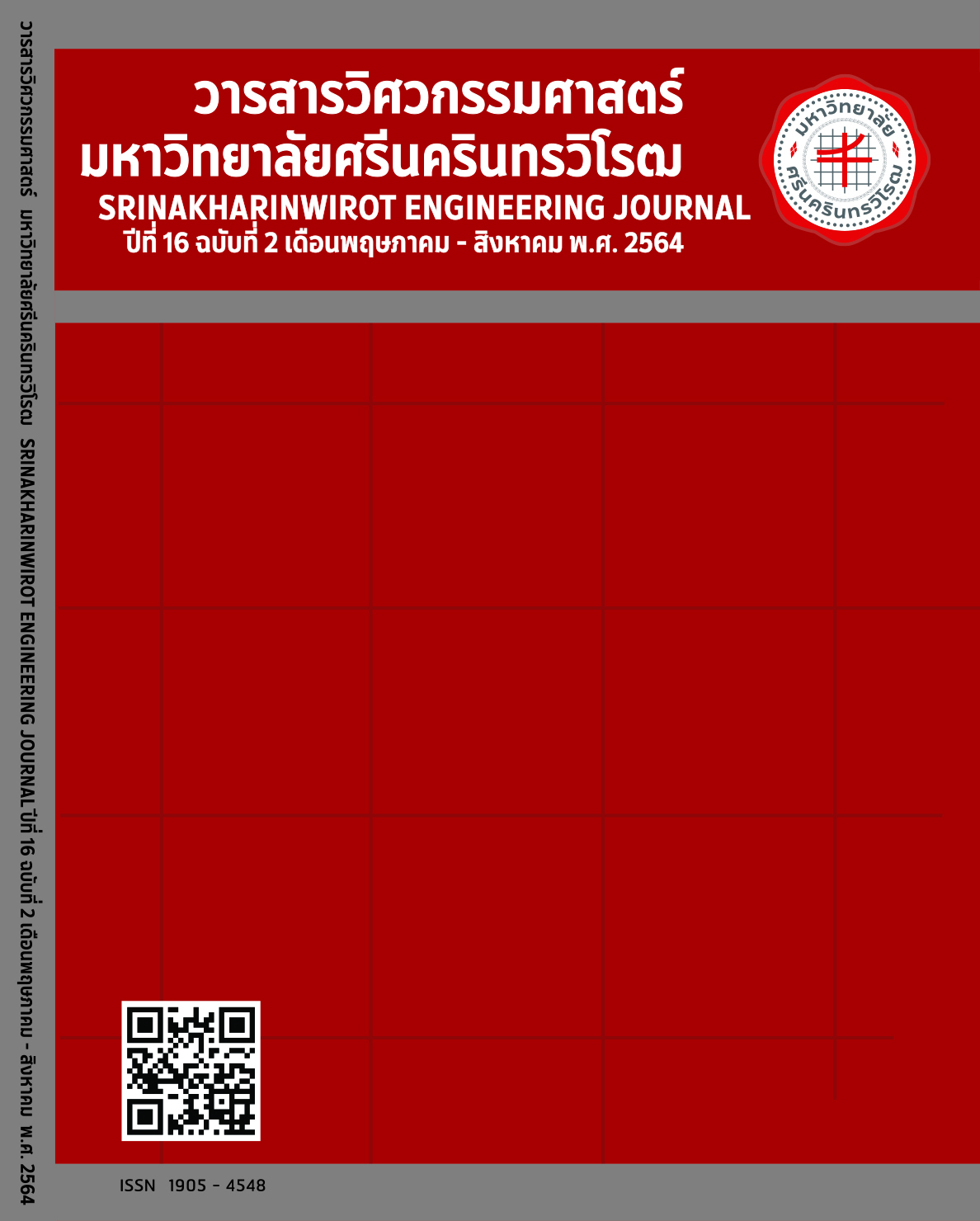Flexural Strength of Fiber-Cement Sheets using Recycled Gypsum Board as Partial Fine Aggregate Replacement
Main Article Content
Abstract
This paper presents the effects of partial fine aggregate replacement by recycled gypsum board in mortar for producing fiber-cement sheets conformed to TIS 1427-2540 Fiber-cement sheets: Flat sheets. The results showed that fine aggregate volume could be replaced by recycled gypsum board up to 0.20 by mortar volume which affected the tested modulus of rupture of 4.03, 4.41 and 4.42 MPa with water to cement ratio (W/C) of 0.40, 0.45 and 0.50, respectively. Those mortars passed the standard of fiber-cement sheets type 1 with the modulus of rupture higher than 4 MPa. However, mortar with recycled gypsum board could not protect water penetration. Therefore, those mortars were put in fiber-cement sheets type A and B that could be used indoor or outdoor without directly facing sunlight and water.
Article Details

This work is licensed under a Creative Commons Attribution-NonCommercial-NoDerivatives 4.0 International License.
Copyright belongs to Srinakharinwirot University Engineering Journal
References
TIS Standard for Gypsum Plasterboard, TIS Standard 219-2552, 2009.
A. Kongsitthanakorn, P. Sangkakit and W. Dampanrat, “A Study on Possibility of Using Synthesis Gypsum for Paving Blocks,” Bachelor’s dissertation, College of Industrial Technology, KMUTNB, 2003.
J. Sriwichai, S. Chareonsukkho, A. Chaiyasith, S. Kongsomsaksiri and N. Yamoth, “Effects of Synthesis Gypsum in Concrete,” Bachelor’s dissertation, College of Industrial Technology, KMUTNB, 2005.
T. Cholatarn, T. Klubprasith, W. Permrith, S. Kongsomsaksiri and N. Yamoth, “Effects of Water Content on Paving Concrete Blocks Made with Synthesis Gypsum,” Bachelor’s dissertation, College of Industrial Technology, KMUTNB, 2004.
N. Noochaya, W. Wisutchanon, S. Piyo, S. Kongsomsaksiri and N. Yamoth, “A Development of Paving Concrete Blocks Made with Synthesis Gypsum,” Bachelor’s dissertation, College of Industrial Technology, KMUTNB, 2004.
TIS Standard for Facing Bricks, TIS Standard 168-2545, 2003.
TIS Standard for Fiber-Cement Sheets, TIS Standard 1427-2540, 1997.
A. Attachaiyawuth, C. Ngamthanachot and C. Vivatvanavong, “Effects of Compressive Strength of Mortar using Recycled Gypsum as Partial Replacement Material,” KMUTT Research and Development, vol. 3, pp. 247-262, Jul. 2019.
WRAP (Waste & Resources Action Programme) (2009, August 5). Recycled Gypsum in Concrete Construction Product Applications [Online] Available: http:www.warp.org.uk/construction
A. Erbs, A. Nagalli, K. Q. de Carvalho, V. Mymrin, F. Hermes Passig and W. Mazer, “Properties of recycled gypsum from gypsum plasterboards and commercial gypsum throughout recycling cycles,” Journal of Cleaner Production, vol. 183, pp. 1314-1322, 2018.
D.A. Kontogeorgos and M.A. Founti, “A generalized methodology for the definition of reactive porous materials physical properties: Prediction of gypsum board properties,” Construction and Building Materials, vol. 48, pp. 804-813, 2013.
J. Zhang, X. Guan, X. Song, H. Hou, Z. Yang and J. Zhu, “Preparation and properties of gypsum based energy storage materials with capric acid–palmitic acid/expanded perlite composite PCM,” Energy and Buildings, vol. 92, pp. 155-160, 2015.
S. Sair, B. Mandili, M. Taqi and A. El Bouari “Development of a new eco-friendly composite material based on gypsum reinforced with a mixture of cork fibre and cardboard waste for building thermal insulation,” Composites Communications, vol. 16, pp. 20-24, 2019.
T. Raghavendra and B.C. Udayashankar, “Engineering properties of controlled low strength materials using flyash and waste gypsum wall boards,” Construction and Building Materials, vol. 101, pp. 548-557, 2015.
H. Liang and J. Li, “The influence of hydration and swelling properties of gypsum on the preparation of lightweight brick using water supply reservoir sediment,” Construction and Building Materials, vol. 94, pp. 691-700, 2015.
M. Garg, A.K. Minocha and N. Jain, “Environment hazard mitigation of waste gypsum and chalk: Use in construction materials,” Construction and Building Materials, vol. 25, pp. 944-949, 2011.
Q. L. Yu and H. J. H. Brouwers, “Development of a self-compacting gypsum-based lightweight composite,” Cement and Concrete Composites, vol. 34, pp. 1033-1043, 2012.
P. Sormunen and T. K?rki, “Recycled construction and demolition waste as a possible source of materials for composite manufacturing,” Journal of Building Engineering, vol. 24, 100472, pp. 1-14, 2019.


